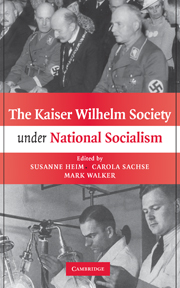Book contents
- Frontmatter
- Contents
- Tables
- Illustrations
- Editors
- Contributors
- Abbreviations
- Archives
- 1 The Kaiser Wilhelm Society under National Socialism
- SECTION I RESEARCH AND PERSONNEL POLICIES
- 2 A Success Story? Highlighting the History of the Kaiser Wilhelm Society's General Administration in the Third Reich
- 3 “No Time to Debate and Ask Questions” – Forced Labor for Science in the Kaiser Wilhelm Society, 1939–1945
- 4 Adolf Butenanbt between Science and Politics: From the Weimer Republic to the Federal Republic of Germany
- SECTION II RACIAL RESEARCH
- SECTION III EASTERN RESEARCH, LIVING SPACE, BREEDING RESEARCH
- SECTION IV MILITARY RESEARCH
- SECTION V THE POSTWAR “POLITICS OF THE PAST”
- Bibliography
- Index
3 - “No Time to Debate and Ask Questions” – Forced Labor for Science in the Kaiser Wilhelm Society, 1939–1945
Published online by Cambridge University Press: 29 July 2009
- Frontmatter
- Contents
- Tables
- Illustrations
- Editors
- Contributors
- Abbreviations
- Archives
- 1 The Kaiser Wilhelm Society under National Socialism
- SECTION I RESEARCH AND PERSONNEL POLICIES
- 2 A Success Story? Highlighting the History of the Kaiser Wilhelm Society's General Administration in the Third Reich
- 3 “No Time to Debate and Ask Questions” – Forced Labor for Science in the Kaiser Wilhelm Society, 1939–1945
- 4 Adolf Butenanbt between Science and Politics: From the Weimer Republic to the Federal Republic of Germany
- SECTION II RACIAL RESEARCH
- SECTION III EASTERN RESEARCH, LIVING SPACE, BREEDING RESEARCH
- SECTION IV MILITARY RESEARCH
- SECTION V THE POSTWAR “POLITICS OF THE PAST”
- Bibliography
- Index
Summary
As the British Royal Air Force stepped up their bombing attacks on the capital of the German Reich as part of the “Battle of Berlin” campaign, the General Administration of the Kaiser Wilhelm Society (Kaiser-Wilhelm-Gesellschaft, KWS) became increasingly concerned about the safety of the staff in their research institutes in Berlin-Dahlem. After tough negotiations with the authorities, the KWS property department finally gained permission to convert the cellar of the Harnack House, the society's main meeting place and lecture hall and, as such, the representative heart of the KWS, into a bunker. As manpower was scarce, the General Administration was obviously glad when in early March 1944 a member of staff of the Kaiser Wilhelm Institute (KWI) for Physical Chemistry negotiated the placement of “further assistant workers… from a concentration camp.” Although it is not recorded whether concentration camp prisoners actually worked on the Harnack House, it speaks for itself that their forced labor on this symbolic place, so central to the corporate identity of the KWS, was even considered.
The subject of forced labor has not been dealt with, even peripherally, in most publications on the history of the KWS. The same is true of most publications on the history of the individual institutes. For this reason, this chapter will look into the extent of forced labor in the research institutions of the KWS.
- Type
- Chapter
- Information
- The Kaiser Wilhelm Society under National Socialism , pp. 47 - 73Publisher: Cambridge University PressPrint publication year: 2009

